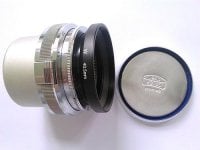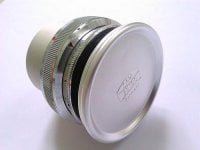largedrink
Down Under
You cannot go wrong with the 21mm Biogon and the 35mm Planar.
Both are desirable high ranking top shelf lenses in their time (1950s) and now , for use or for collecting.
Thanks, does the higher cost of the Planar 35mm justify the image quality over the 35mm Biogon? Or is the 35mm Biogon a better lens for image quality.
xayraa33
rangefinder user and fancier
Thanks, does the higher cost of the Planar 35mm justify the image quality over the 35mm Biogon? Or is the 35mm Biogon a better lens for image quality.
Both are fine lenses.
The f2.8 vs the f 3.5 aperture might sway you to the faster lens but it is not a huge gain in speed in my opinion so I would go with the rarer lens, as the 35mm Biogon is easily found for sale on a regular basis...and if you ever plan to sell the Planar then you will find it will sell faster... as it is a rarer lens to collectors and the price whether buying or selling will reflect that.
Cascadilla
Well-known
To your original question--I don't think there is anything to choose in terms of maintenance on any of the three post war Zeiss lenses that you mentioned. I own all of them and have found them all to be excellent performers. There is a big difference in the angle of view from a 35 mm vs. a 21 mm lens so you might want to get a 35 and the 21 rather than the two 35's. The only reason I own the 35 mm Planar is that a large photo retailer rated mine as being in marginal condition and sold it at a very reasonable price. I was delighted when I opened the package and found a lens in excellent condition. For simply making pictures the Planar isn't worth the premium over the Biogon, in my experience. It's a good lens but not better than the Biogon.
markjwyatt
Well-known
To your original question--I don't think there is anything to choose in terms of maintenance on any of the three post war Zeiss lenses that you mentioned. I own all of them and have found them all to be excellent performers. There is a big difference in the angle of view from a 35 mm vs. a 21 mm lens so you might want to get a 35 and the 21 rather than the two 35's. The only reason I own the 35 mm Planar is that a large photo retailer rated mine as being in marginal condition and sold it at a very reasonable price. I was delighted when I opened the package and found a lens in excellent condition. For simply making pictures the Planar isn't worth the premium over the Biogon, in my experience. It's a good lens but not better than the Biogon.
The Biogon is developed from the Sonnar. The Planar is a much older design. I suspect both are excellent.
TenEleven
Well-known
The (post war) Biogon 2.8 is a nice lens. As Mark above me correctly stated it was developed from the Sonnar formula to add a wide lens to Zeiss' lineup. The post-war version was recomputed to be shorter as to fit on the smaller IIa/IIIa cameras. Performance wise it's very close to the pre-war original with only minor differences that would only show up in a side-by side comparison.
The Planar 35/3.5 is an older design, as stated, and due to using less glass in the light path has punchier contrast. It also is sharp across the entire frame from wide open. No distortion either but you lose around a stop and it is the much rarer and thus more pricy lens.
The post-war Biogon needs to be nudged to a little bit above f/4.0 for the entire frame to be pin-sharp. The pre-war version is a tiny bit better here, perhaps due to not being constrained by length. At f/2.8 however the inner 2/3rds of the frame are already very sharp with just the corners lagging a bit until with either Biogon.
At f/5.6 and up there is almost no easily discernible difference between these two (three including the prewar lenses) lenses anymore.
The Planar 35/3.5 is an older design, as stated, and due to using less glass in the light path has punchier contrast. It also is sharp across the entire frame from wide open. No distortion either but you lose around a stop and it is the much rarer and thus more pricy lens.
The post-war Biogon needs to be nudged to a little bit above f/4.0 for the entire frame to be pin-sharp. The pre-war version is a tiny bit better here, perhaps due to not being constrained by length. At f/2.8 however the inner 2/3rds of the frame are already very sharp with just the corners lagging a bit until with either Biogon.
At f/5.6 and up there is almost no easily discernible difference between these two (three including the prewar lenses) lenses anymore.
largedrink
Down Under
Thanks for the useful comments everyone. Are there any known problems I should check before purchasing, other than oily aperture blades and fog?
The collector in me is tempted to buy all 3 lenses as the 35mm Planar is in mint condition. The 35mm Biogon is more of a user but I kind of favor it for the lower price and can't really justify buying two 35mm lenses. The 21mm comes with a finder with cracked glass on the front side, I'd aim to find someone or something that can repair glass cracks.
The collector in me is tempted to buy all 3 lenses as the 35mm Planar is in mint condition. The 35mm Biogon is more of a user but I kind of favor it for the lower price and can't really justify buying two 35mm lenses. The 21mm comes with a finder with cracked glass on the front side, I'd aim to find someone or something that can repair glass cracks.
Last edited:
Highway 61
Revisited
The main fact is that the postwar Planar 35 is now highly sought after by collectors and can sell for what the Biogon 21 does. I used to have one (got by chance in a misc. camera gear lot) and I re-sold it to an Asian collector gentleman eventually, who was extremely happy with it, as I was told later. With more than 75 bids this was the most disputed camera gear item I put for sale on the big auction site ever, with even the second bidder wanting it so desperately that he tried to have eBay cancel the auction results. Oh well.Thanks, does the higher cost of the Planar 35mm justify the image quality over the 35mm Biogon? Or is the 35mm Biogon a better lens for image quality.
I still have my postwar Biogon 35 and I use it from time to time on my Nikon RF bodies. I couldn't really see differences in results between those two postwar Zeiss 35mm lenses. At the time both the two were in my house, I was still shooting a bit of color film - totally resumed with it now - and the Planar 35 had a very noticeably colder colors rendition. The Planar 35 was also lighter. But for me the postwar Biogon 35 was the real McCoy.
The Biogon 35 (either prewar or postwar) can accomodate a standard tilted vented lens hood copy of the Leitz 12585 hood. Such a hood, although designed for 50mm lenses, won't get into the Biogon 35 FOV and hence will be very efficient against flare. On the contrary, it will be seen in the corners of the photos taken with the postwar Planar 35, which will need a wider hood (either the original bowl-sized Zeiss hood or a tilted-vented copy of the Leitz 12504 hood).
Bottom line : if you are a collector, sooner or later you will want a Biometar too :
https://www.pacificrimcamera.com/pp/zicontax35f28a.htm
Cascadilla
Well-known
I suspect that the only repair for the 21 mm finder would be to find a donor finder for the piece of cracked glass, so probably not that economical. I use a Zeiss post war #440 finder for my 21 and other lenses and like it. It has diopter correction built in so i can see the entire field by shifting my glasses down and still see a sharp image. I'm not aware of any single focal length Zeiss finders that have this option.
Elmar Lang
Well-known
Being myself a Contax-fan and above all user, I have the prewar Biogon in both the uncoated and coated version, resp. Nr. 2612736 (this one, recently purchased within a Contax outfit) and the "T", Nr. 2673494. The second one, performs excellently. The uncoated Biogon is surely interesting, but in the short test done until now, I'd always use it with a sun-shade.
My favourite though, is the less-known, postwar Carl Zeiss Jena Biometar 35/2,8 "T": my example is Nr. 3234253 and was bought by my grandfather, back in the early 50s. I understand though, that it's not easy to find and consequently, it commands quite high prices.
I have the postwar Zeiss (West) Biogon, that's an extremely fine lens too, but after my personal taste, I prefer the Biometar.
I've had a 35mm. Planar too: bought like brand new at a camera shop in my city, in 2002; used for one year and sold with no regret to a german camera collector.
The Soviet Jupiter is a fine lens too: a well-mounted/calibrated specimen, can be very satisfying!
Best wishes,
Enzo (E.L.)
Never had the 21mm. One day, I will buy one...
My favourite though, is the less-known, postwar Carl Zeiss Jena Biometar 35/2,8 "T": my example is Nr. 3234253 and was bought by my grandfather, back in the early 50s. I understand though, that it's not easy to find and consequently, it commands quite high prices.
I have the postwar Zeiss (West) Biogon, that's an extremely fine lens too, but after my personal taste, I prefer the Biometar.
I've had a 35mm. Planar too: bought like brand new at a camera shop in my city, in 2002; used for one year and sold with no regret to a german camera collector.
The Soviet Jupiter is a fine lens too: a well-mounted/calibrated specimen, can be very satisfying!
Best wishes,
Enzo (E.L.)
Never had the 21mm. One day, I will buy one...
largedrink
Down Under
I purchased the 21mm 4.5 Biogon and 35mm 2.8 Biogon, both are designated Carl Zeiss. I think I got them for a reasonable price. I'll post photos of them once they arrive. I couldn't bring myself to spend more on the 35mm Planar even though it's in mint condition.
Has anyone had any success repairing cracked finders or lenses using products that would seep into the crack to bond it and reduce its visibility (like I have seen done with car windscreens)? I'm hoping to be able to improve the cracked 21mm finder if I can, I imagine donor finders will be difficult to come by Cascadilla, unless the front glass is interchangeable with finders of other focal lengths.
Has anyone had any success repairing cracked finders or lenses using products that would seep into the crack to bond it and reduce its visibility (like I have seen done with car windscreens)? I'm hoping to be able to improve the cracked 21mm finder if I can, I imagine donor finders will be difficult to come by Cascadilla, unless the front glass is interchangeable with finders of other focal lengths.
Highway 61
Revisited
I just had a look at my own Zeiss Ikon #435 21mm finder. I had taken it apart to clean it when it arrived in the mail long ago but I don't remember whether the front glass is either a neutral element or a diopter - and I won't open it again to make up my mind about it.Has anyone had any success repairing cracked finders or lenses using products that would seep into the crack to bond it and reduce its visibility (like I have seen done with car windscreens)? I'm hoping to be able to improve the cracked 21mm finder if I can, I imagine donor finders will be difficult to come by Cascadilla, unless the front glass is interchangeable with finders of other focal lengths.
It's very slightly curved and looks to be cut off a spherical lens so it very probably can be replaced by a custom-made element which you can get from a prescription glasses supplier.
Take the finder apart when you get it and you'll see by yourself. You only have to remove the two screws on both the sides of the front chrome cover, then everything will come out easily.
Once you have it out of the finder assembly, I guess that any optician can cut a new element for you in either a neutral lens or in a dioptric one. Such a professional will find out what spare diopter matches the original cracked front element if it's not a neutral one. You will lose the small circle engraved in the original front element but at the end of the day it's a useless thing.
UV-curing glass cement will probably work too, but for the price of the glue you can have a cleaner fix done IMO.
largedrink
Down Under
The 21mm and 35mm turned up! Such heavy and beautifully engineered lenses. The 21mm looks to have some fungus on one of the rear elements unfortunately.Looking forward to my next photo walk...
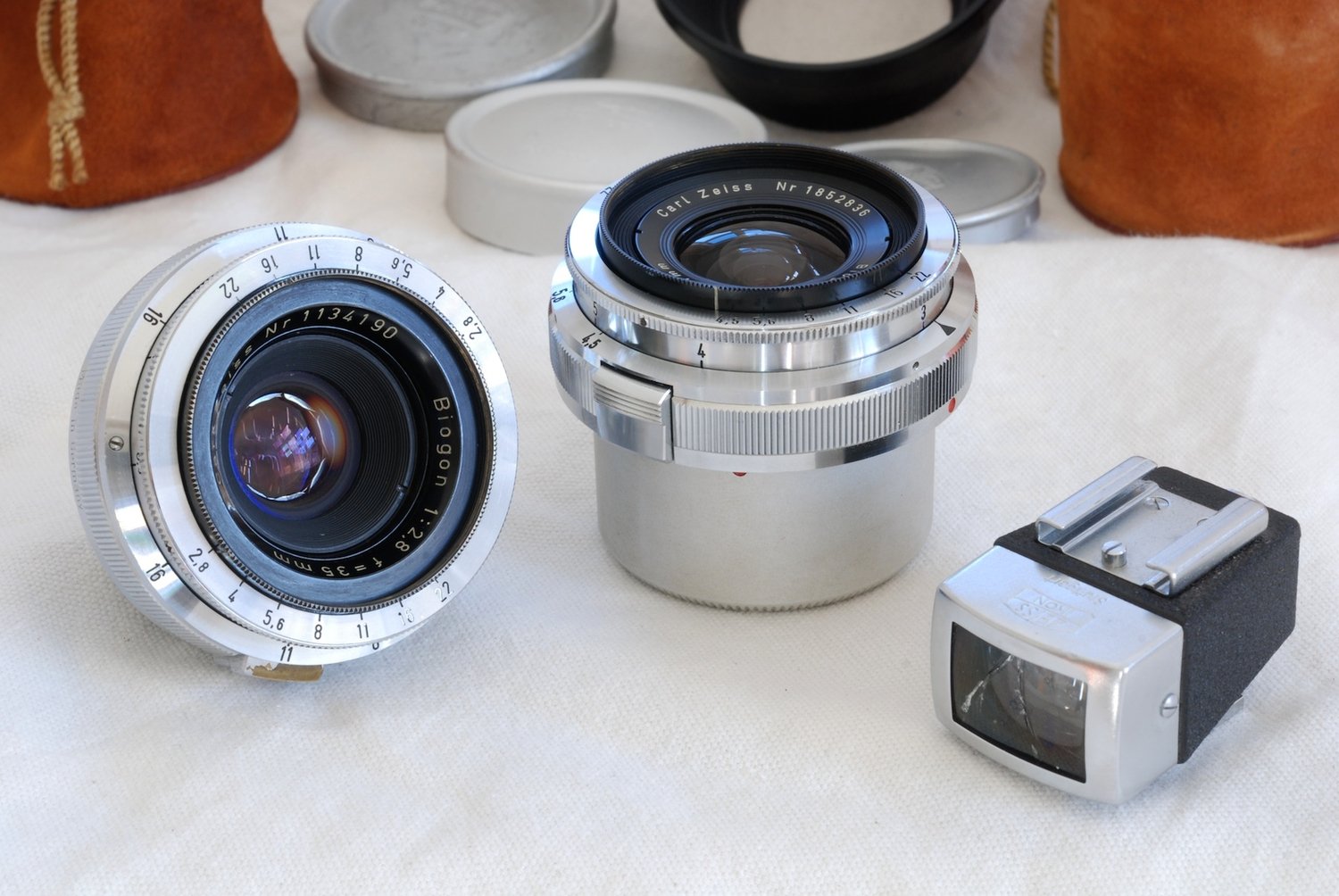

S.H.
Picture taker
The main fact is that the postwar Planar 35 is now highly sought after by collectors and can sell for what the Biogon 21 does.
I'm quite surprised the price of these lenses went up... I thought the bottom fell off and nobody used those things.
I have been away for some time from RFF : busy at work, and I took a few hours each week in a photoclub to learn to properly use a wet darkroom: not much time to be on the photo forums. I mostly used Ms and Hasseblad but I feel ready to delve again in collectibles... I see that the gear I like is less often found for sale.
I just bought a Nikon S3 in Japan to use the various 35s in Contax mount I have more comfortably, the metal finders (internal or external) of the old Contax tend to scratch my glasses. I'm using more and more 35s and a bit less 50s.
Here is what I accumulated 5-10years ago, usually not for too much money:
*Russian J-12 - not bad!
*a rare Biogon in native ltm (can't mount it on M, so I very rarely used it)
*Jena prewar Orthometar (!) - if I recall correctly, it can be used on an Amedeo adapter and on my M8, not bad at all, even surprisingly good! I don't know if it can be found easily though...
*Russian 28mm Orion - same as orthometar, no rf coupling
*postwar Zeiss planar - not used yet, because the focus ring is a bit hard
I may even have another Biogon it its regular Contax mount somewhere...
Ironically, the Orthometar and the Planar were bought cheap with Contax bodies, nobody wanted these things.
I'll have some work finally using and comparing these, when the S3 has arrived!
Larry Cloetta
Mentor
.........
The Biogon 35 (either prewar or postwar) can accomodate a standard tilted vented lens hood copy of the Leitz 12585 hood. Such a hood, although designed for 50mm lenses, won't get into the Biogon 35 FOV and hence will be very efficient against flare. On the contrary, it will be seen in the corners of the photos taken with the postwar Planar 35, which will need a wider hood (either the original bowl-sized Zeiss hood or a tilted-vented copy of the Leitz 12504 hood).

Thanks for the above, that’s helpful. Any ideas on a hood for the 21mm Biogon?
Highway 61
Revisited
You're welcome, Larry.Thanks for the above, that’s helpful. Any ideas on a hood for the 21mm Biogon?
On my 21mm Biogon I use a wide, flat, not vented generic black metal screw-in 40.5mm lens hood which was around in the early 2000's on evilBay. I had bought it for my 35mm Biogon until I realized that I could use something more efficient on the latter.
I always leave it on the 21mm Biogon and I use a nice push-on aluminum "Carl Zeiss" lens cap (coming from the Contarex range I guess) on it. From memory that lens cap is a 62mm push-on model.
Looks like the recent 40.5mm screw-in tilted-vented copies of the Leitz #12504 lens hood (accomodating 58mm clip-on lens caps) will work well on the 21mm Biogon without getting into the lens FOV. Look at eBay item #362568999094 for instance (many sellers around will offer the same item, in either silver or black finish). I have one but in 43mm screw-in (for my W-Nikkor-C 28mm f/3.5 in S-mount) thus I cannot double-check this, but you can take the plunge IMO.
Of course, no protective filter or the lens hood will be seen in the corners of the photos ! With the 21mm Biogon, well, it's either a filter or a lens hood, not both.
Larry Cloetta
Mentor
You're welcome, Larry.
On my 21mm Biogon I use a wide, flat, not vented generic black metal screw-in 40.5mm lens hood which was around in the early 2000's on evilBay. I had bought it for my 35mm Biogon until I realized that I could use something more efficient on the latter.
I always leave it on the 21mm Biogon and I use a nice push-on aluminum "Carl Zeiss" lens cap (coming from the Contarex range I guess) on it. From memory that lens cap is a 62mm push-on model.
Looks like the recent 40.5mm screw-in tilted-vented copies of the Leitz #12504 lens hood (accomodating 58mm clip-on lens caps) will work well on the 21mm Biogon without getting into the lens FOV. Look at eBay item #362568999094 for instance (many sellers around will offer the same item, in either silver or black finish). I have one but in 43mm screw-in (for my W-Nikkor-C 28mm f/3.5 in S-mount) thus I cannot double-check this, but you can take the plunge IMO.
Of course, no protective filter or the lens hood will be seen in the corners of the photos ! With the 21mm Biogon, well, it's either a filter or a lens hood, not both.
Thanks, will give that a shot. Might even have one in a box somewhere. Have only recently acquired the 21 Biogon, so hadn’t worked that out yet. Had the 21mm Voigtländer, but found it too contrasty, inasmuch as it seemed out of character with the other Zeiss lenses, always crushing the blacks and the highlights, so finally sprung for the Biogon. So, now am thinking hood to improve the contrast
Highway 61
Revisited
Actually those wide, pancake lens hoods which must be used with 28mm and 21mm rangefinder lenses will have two and only, yet very interesting, benefits :So, now am thinking hood to improve the contrastNeed it to be juuuussst right.
- they will keep your left hand fingers out of the frame while grasping the lens barrel for focusing,
- they will protect the lens nose against rubs and bumps.
As for really protecting the lens front element from oblique parasite light rays and thus, improving the contrast and decreasing the flare, well...
Anyway, as you have probably found it out yourself already, the classic CZ 21mm Biogon f/4.5 has an exceptional resistance to flare for such a vintage shell with single coatings.
Highway 61
Revisited
Attached to this post are snaps of my 21mm Biogon with its small generic "W" 40.5mm screw-in lens hood from the era just before those nice generic Chinese CNC-machined hoods became almost all tilted-vented models. I have the original matte aluminum push-on front cap for the lens, marked "Carl Zeiss Germany", but as said above I use that shiny aluminum push-on lens cap which doesn't belong to the Contax RF family but - if I guess it right - rather to the Contarex one (marked "Carl Zeiss Germany" as well) and which allows to leave the hood on the lens all the time. After another measurement it shows to be a 49mm push-on lens cap with a like new blue felt lining and it holds in place very firmly on the hood - a piece of luck.
Attachments
largedrink
Down Under
I promised I'd post some photos from my newly acquired Contax 21mm and 35mm lenses, I am very impressed (understatement!) with how these lenses perform! They were taken with an also new-to-me Contax IIa and I am really happy that it performed well too.
Zeiss Biogon 21mm at f16
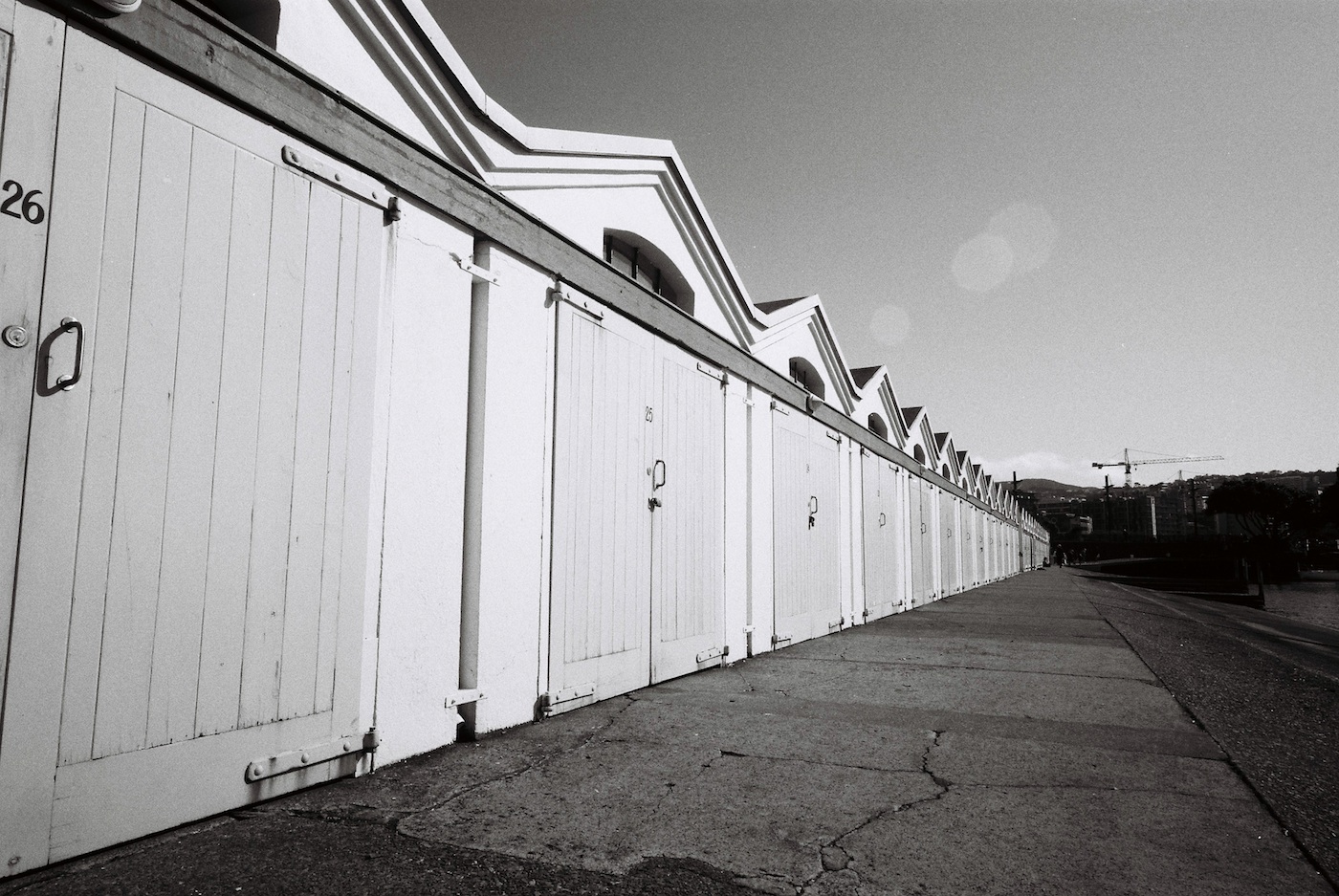
Zeiss Biogon 21mm at f11
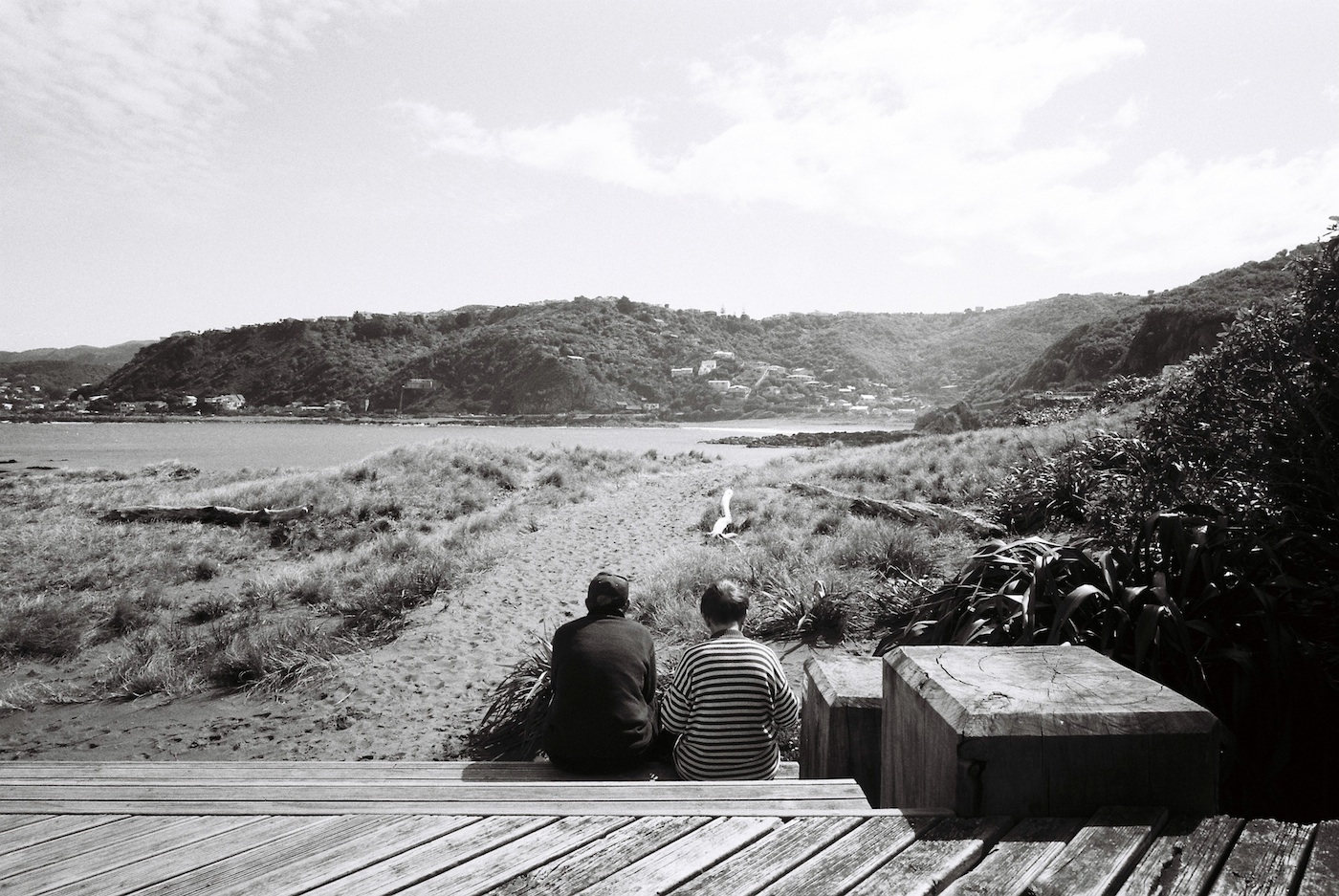
Zeiss Biogon 35mm at f16
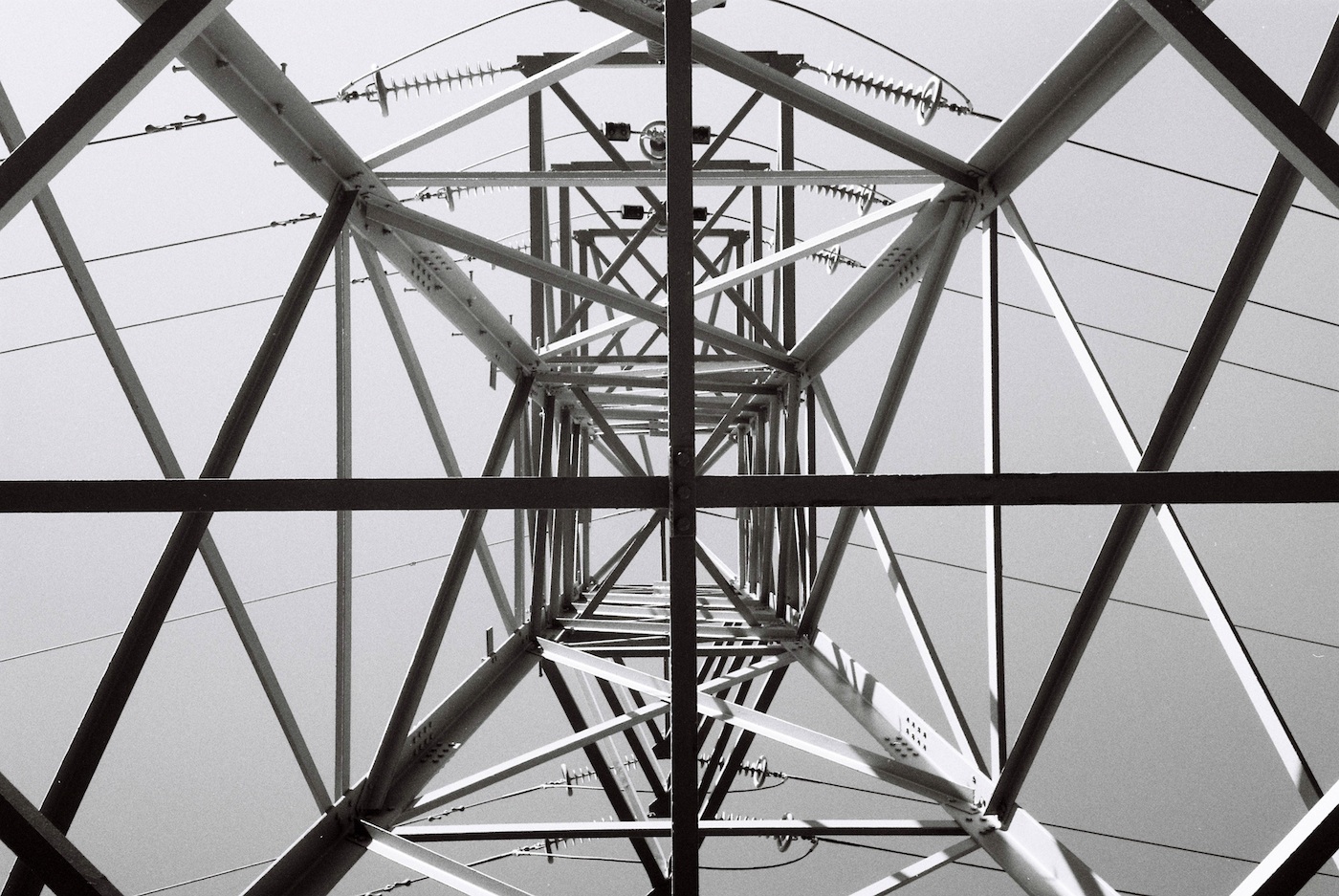
Zeiss Biogon 35mm at f8
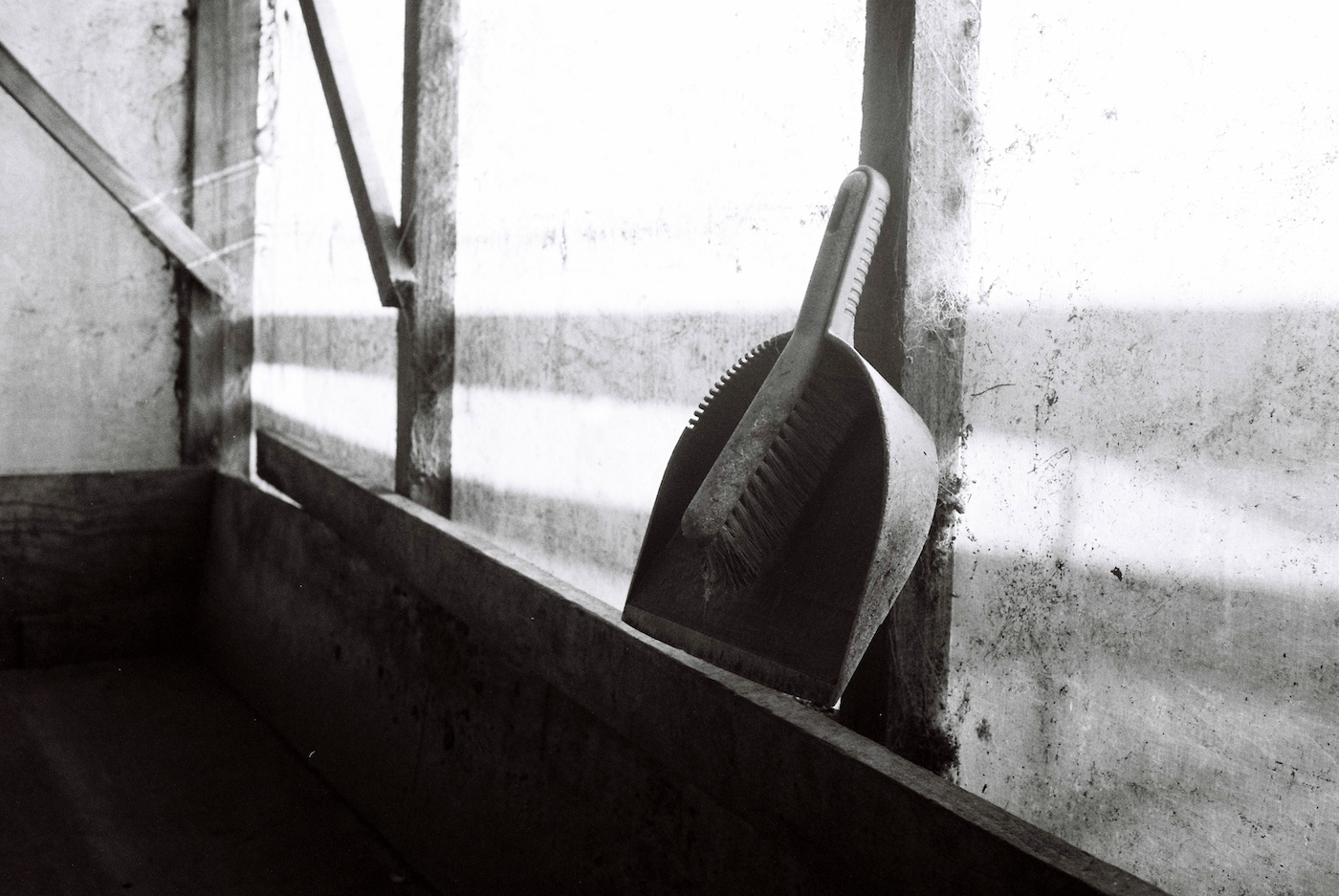
Zeiss Biogon 21mm at f16

Zeiss Biogon 21mm at f11

Zeiss Biogon 35mm at f16

Zeiss Biogon 35mm at f8

Bingley
Mentor
I got a Zeiss Biogon 35mm f2.8 for my Contax IIa and am really pleased with it.
 In line by bingley0522, on Flickr
In line by bingley0522, on Flickr
 American River by bingley0522, on Flickr
American River by bingley0522, on Flickr
 Angles by bingley0522, on Flickr
Angles by bingley0522, on Flickr
 In line by bingley0522, on Flickr
In line by bingley0522, on Flickr American River by bingley0522, on Flickr
American River by bingley0522, on Flickr Angles by bingley0522, on Flickr
Angles by bingley0522, on Flickr
Share:
-
This site uses cookies to help personalise content, tailor your experience and to keep you logged in if you register.
By continuing to use this site, you are consenting to our use of cookies.


